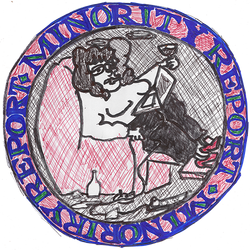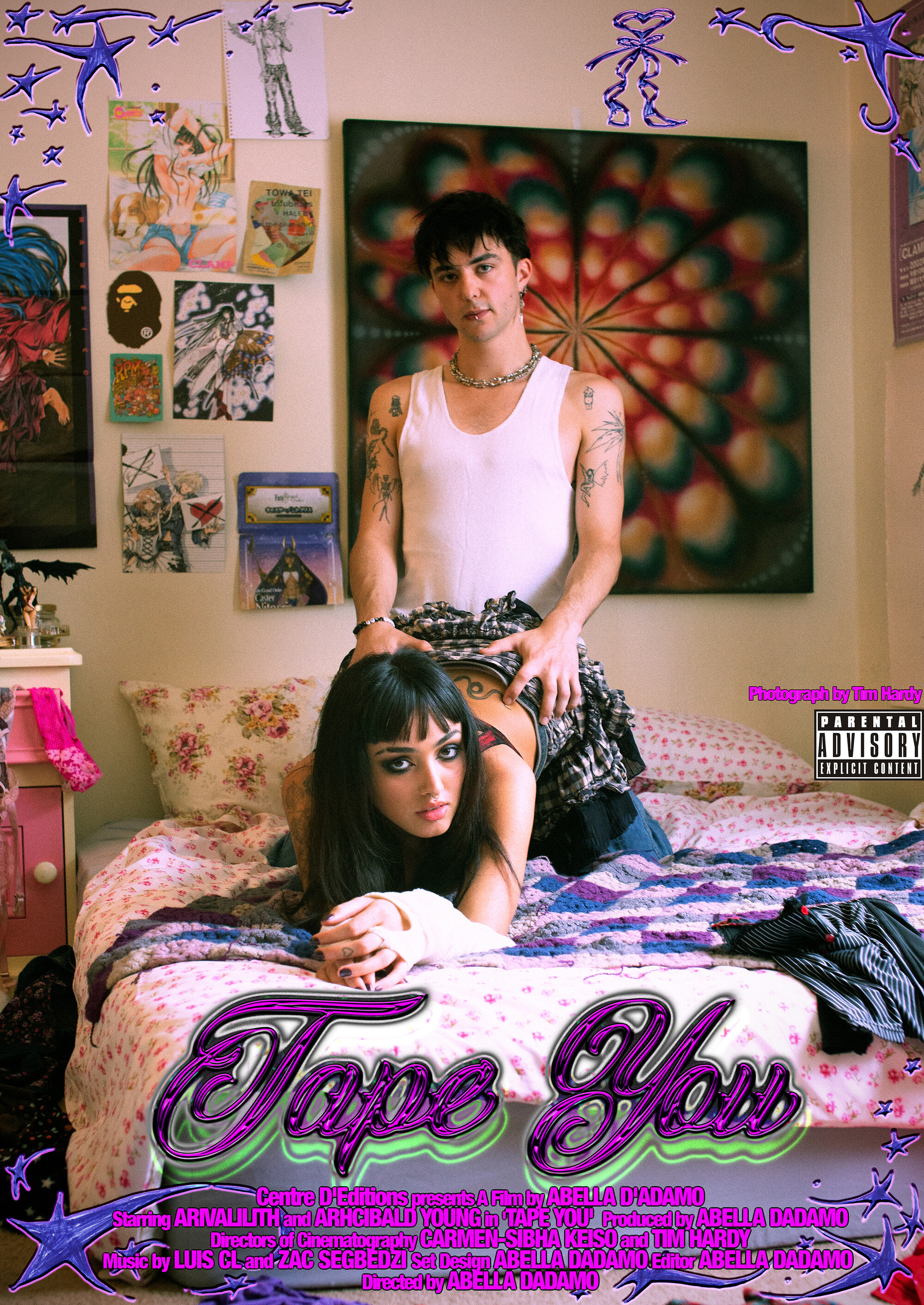
The now infamous Miu Miu spring 2022 micro-mini skirt is said to have heralded the “return” of Y2K Paris Hilton aesthetics. But anyone hawking their wares on Depop or Facebook Marketplace (or worse, Etsy) will tell you that the Y2K revival has come and gone. Others have micro-genrified the return of micro-mini by attributing it to a “McBling” revival (also known as Hollywood Trashcore) rather than a Y2K one (although often lumped together). Beginning at the inevitable post-2000 decline of the Y2K aesthetic, McBling really kicked off around 2004 with the release of Myspace, the iPod and Paris Hilton’s The Simple Life (2003-2007). Though the McBling era had come to a close by 2008 and its intersecting cousin took over with Tumblr, Soulseek, Facebook, electroclash, bloghouse, Cobrasnake, Cheap Monday, Suicide Girls, American Apparel, Hipster Runoff. It was indie sleaze. It was closely related to “scene” and emo. Not the mid-1980s hardcore thing, the 2002 mainstream revival.
If it all seems muddled, flattened, overlapping, it’s because it is. After Y2K everything disintegrated as through the millennium bug prophecy referred to style, fashion, subculture, music. It’s all very Mark Fisher. The nostalgia of form, the naturalisation of pastiche, appropriation that is assumed rather than signaled, a depthless contemporary with an intolerance of the recent past. The ouroborous gagging on its own tail looks more and more like autofellatio. Thank god 2006 is back in fashion, because otherwise it’d be entirely uncool to blog about hauntology, which is haunting itself. Still, perhaps the ghostly presence of what came before is only perceptible to millennials and their elders (we see dead people).
No one argues that the internet sped up the twenty to thirty year cultural trend cycle, and now that we are just over a decade since the OG indie sleaze, it continues to close in on itself. Blink and you’ll miss it because the revival itself is almost already played out with articles being published on its return as early as October last year (The Face, Interview, Nylon, Paper, Bazaar, Dazed). Uncut Gems (2019, set in 2010) was earlier still, and it was even earlier for fashion label Gauntlet Cheng who included Cobrasnake it-girl Cory Kennedy and rats nest hair pieces on the runway along with Melbourne’s own Tashroxx for their 2017 ready-to-wear fall collection—just a few years after the trend was declared DOA. For some it seems it never died in order to be revived, best illustrated by Meg Superstar Princess (and maybe the eldest of Melbourne’s own abject/grotty It Girls such as Brennan Olver AKA Wet Kiss and me—not that we need another categorisation). Or Rex Butler, who still insists on using the term “hipster” even though it was declared dead by 2009.
The indie sleaze moment of bloghouse, tumblr, soulseek etc. set the bar for how the internet came to spread culture. It was also the last moment before everyone had a HD camera and internet access in their pockets, so scene queens relied on front-flash party photography to populate their social profiles. Of course, it will mean different things to different people depending on their psychogeography—despite its entanglement with the early days of social media and the “death” of subculture as it was traditionally understood. In Melbourne, there was Street Party, Click Click, St. Jerome’s and so on. It was also the heyday for Melbourne-based “feminist”/softcore pornographic companies like Feck and Girls Out West. Notably, in peak indie sleaze timespace, Australian feminist filmmaker Anna Brownfield debuted her softcore pornographic film The Band (2009), featuring scenes shot at the well-known indie rock establishment The Tote replete with low-rise micro-minis and emo (self-h)arm-warmers.
When I watched Abella D’Adamo’s new pornographic work Tape You at Centre D’Editions last week, I couldn’t ignore its sleazy ouro-fellatio cultural context. I saw the thematic and aesthetic cues of The Band and Girls Out West re-appear. Actress Ariva Lilith has all the stylistic touchstones of a Suicide Girl, but these days would be best described as “e-girl” (itself a throwback—Urban Dictionary’s first entry was posted in June 2009—and again, practically indistinguishable from emo). Her barely-legal American Apparel physique graces the screen alongside Archibald Young—different tattoos, same flavour—surrounded by beanbags for attendees to peep their union. On arrival, gallery co-director Zac Segbedzi was selling Sex on the Beach cocktails and popcorn. A lifesize cardboard cutout of the duo stands tall in the shop/foyer area picturing Lilith staring down the barrel of the camera, chin in palm, listless, deadpan. Her skirt is hitched up and Young has his hands on her hips, looking down at it, doggie style. All atop the film’s title in purple capital letters: TAPE YOU.
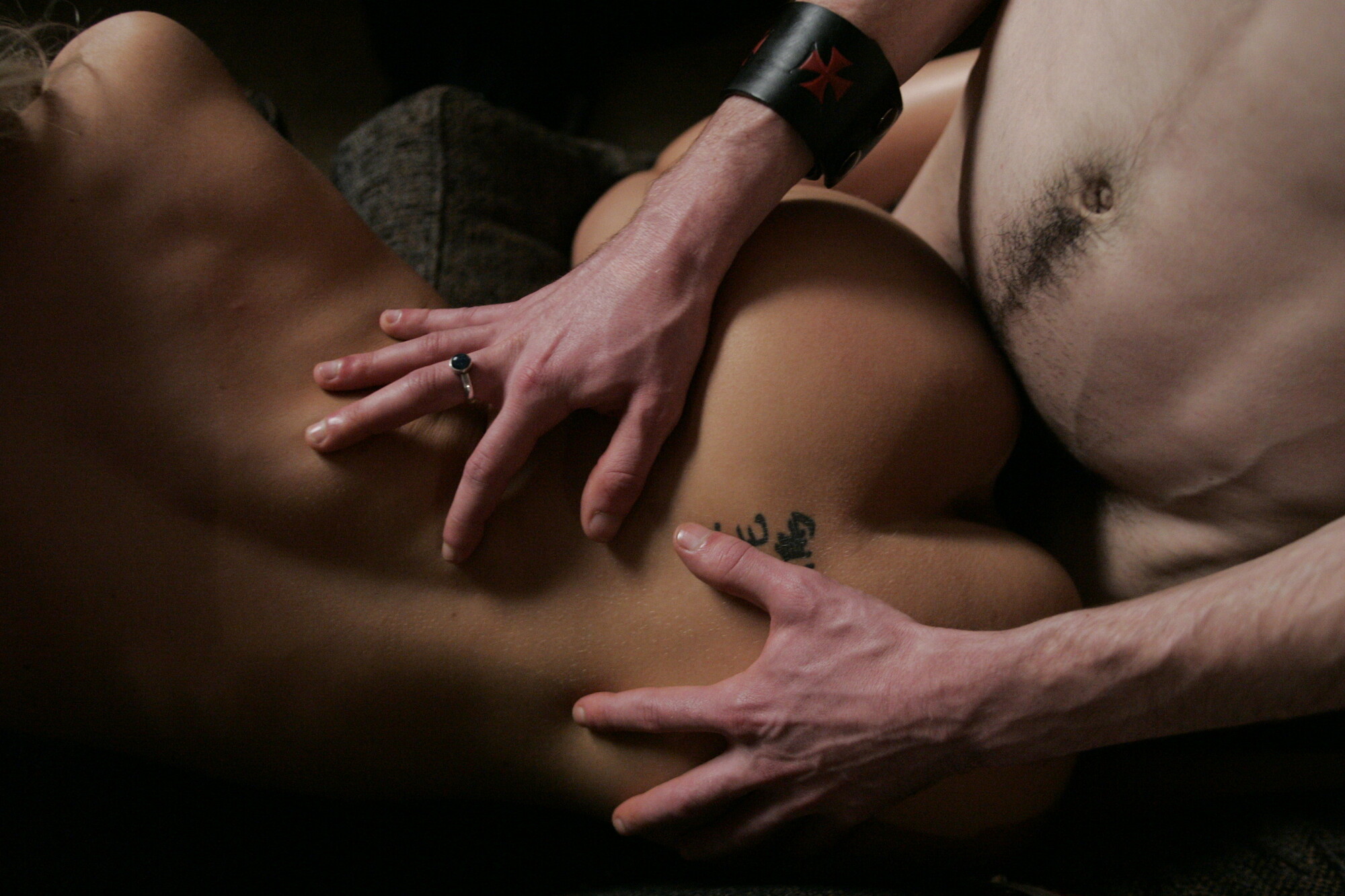
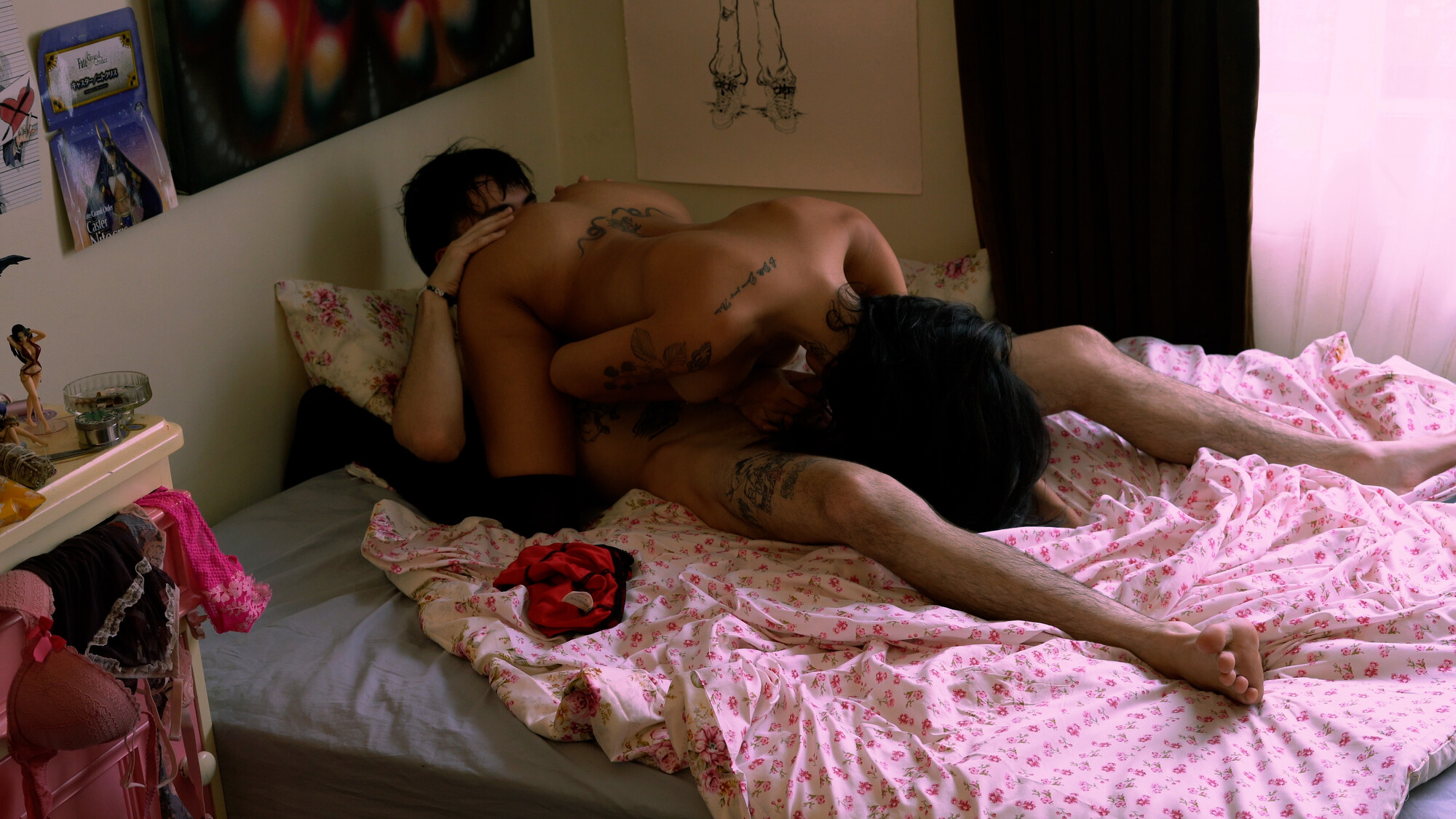
Under the dim red spotlight that illuminated the cinematic gallery space, the audience appeared mixed but predominantly male with a few non-scene walk-ins. One white-haired gentleman lurked in the corner and sat through at least three or four runs of the twenty-five minute feature. His presence gave the affair the vintage feel of early grindhouse and adult movie theatres—before VCR, the internet and homevideos saw the drastic reduction in the need for such communal viewing experiences. The couple runs through all the classics: BJs, doggie, 69, cowgirl, he cums on her tits and the jump-cuts give it away as a one-camera shoot.
Porn was extremely hot during the indie sleaze era. Pop culture and porn culture came to be understood as a spectrum, normalised, unremarkable and increasingly accepted. American Apparel used pornographic actresses in their advertisements such as Lauren Phoenix (2005), Sasha Grey (2009) and Faye Reagan, also known as Faye Valentine (2009). Porn got post-postmodern because all those significant dichotomies—low and high culture, pornography and art, passive feminine and active masculine—had already been challenged by the old guarde (Carolee Schneemann, VALIE EXPORT, Annie Sprinkle, Karen Finley, Andrea Fraser etc.).1 Girls Out West and Feck popped onto the scene with an explicitly anti-mainstream-pornography stance, throwing around words like “real”, “natural”, “sincere”, “honest” and even “dignity”, taking care to mention their predominantly female crews with a hint of women’s liberation discourse. “Want to see the bad side of the good GIRL NEXT DOOR?” coaxes the GoW website. Cotton panties, sundresses, minimal makeup, tattoos discouraged (that’s a Suicide Girls thing), pubes and pit hair. The Girl Next Door is a fetish in herself, just as constructed as any fake-tittied, waxed, bleached and seasoned pornographic actress (and conversely both are “real”). At the end of the day, there’s a clientele to cater to and a boss that’s not you just like any other service industry job. But the Girl Next Door archetype rests on the premise that if male sexuality is violent and perverse, female sexuality is its opposite—natural, uncontaminated, dignified—even if she gets a bit “bad” from time to time.
Amateur porn (which generally refers to the actors rather than the production values) has seen an expansion in content production and distribution in recent years due to austerity, the rise and rise of the gig economy and new formats such as OnlyFans, MyFreeCams and Chaturbate. Yet Pornhub’s yearly reviews show that while the top searches in 2019 were “amateur” and “POV”, it has since shifted. In 2020 the top search was “quarantine” and in 2021 it was “hentai”, closely followed by “romance” which saw a 139% increase (alongside a 139% increase in “passionate” searches). It makes sense that after two years of isolation, relationship breakdowns and loneliness people crave some sort of more “authentic” intimacy. Yet this is offset by what appears to be its polar opposite, the penultimate non-human fantasy of hentai which is 76% more likely to be searched by zoomers than older age groups.
It is not surprising then that horny manga characters and plush toys also feature in the set of Tape You as well as on the walls and in the display cabinet at Centre D’Editions. D’Adamo’s own manga-inspired characters are also included as a part of this universe. But what is the goal of reproducing the pornosphere with all its fantasy/reality dualities so precisely? Someone at the opening made the very good point that after so many shows at Centre D’Editions that skirt around the idea of sex and pornography (notably: Porn: squared, hung, drawn, quartered by Alex Vivian; Segbedzi’s Sex is Gay: Part Deux catalogue; the Collectibles poster; Segbedzi’s work in Collectibles), it’s refreshing to see them “actually just do it”. And perhaps it’s also a backlash to “good taste”, something that also defined indie sleaze with its imprecise makeup, garish lamé, plastic accessories and micro-minis. Centre D’Editions’ t-shirt obsession is also a bit sleazy (Vogue, GQ, Dazed, The Iconic and ASOS all reported that graphic tees are an essential staple for getting the indie sleaze look).
What was surprising was Harriet Morgan’s exhibition text for Tape You, which included all the same key words one would expect to find on Girls Out West or Feck, replicating Girl Next Door linguistic conventions, replete with musty old feminist moralism. Words like “amateur”, “candid”, “realness”, “cotton panties”, “truth”, “female gaze”. It also took pains to glibly distinguish Tape You from “mainstream or popular forms of modern-day pornography”, from “the unrealistic and unattainable acts resulting in potential addiction purely marketed, male directed, capitalised fast food performative sex”. Is Tape You just an earnest replication of a broad genre of anti-porn porn? And if so, was Feck and Girls Out West really the zenith of feminist pornography such that it doesn’t need updating before plonking it in the gallery?
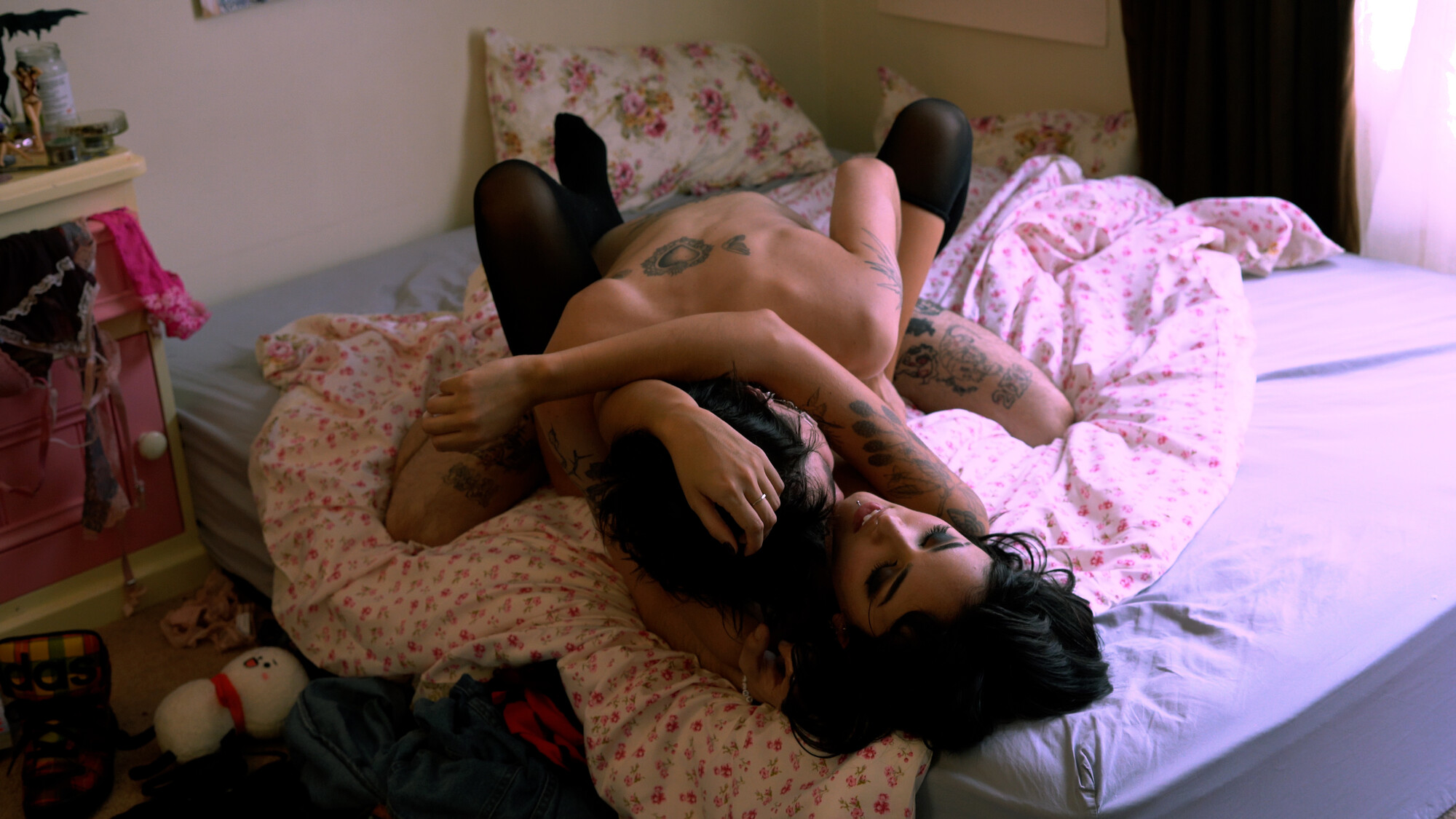
From 2010 to 2016, the most turbulent half of my twenties, I had my face buried in the Girl Next Door. By virtue of doing it for the camera, my wet lips and earthy tits are frozen in time on a plethora of free streaming sites, some with over a million views (regrettably more than I could hope for in my independent publishing career and a real barrier for my hireability in others). At one company, I edited pornos nine to five, Monday to Friday. I sat there with a spliff perpetually hanging from the corner of my mouth, collecting the refuse in a long limp cylinder of stationary ash, forgetting to drink water or eat in that hypnotism of hyper-focused repetition. Long enough for pussies to look like elbows and for my sex drive to plummet. Long enough for the optimism and disconnected academicism of gender studies, of sex positivity, to sink into putrefied cynicism. Sex work is real work and real work is often demoralising. Plus, pouring all your libidinal energy down the work-drain is not a sex work-specific problem.
The staff had jack-off all-trades roles. I often recruited models, directed, shot, acted and operated the boom. Open-cell foam and artificial fur trembling at the entrance to someone’s cunt, capturing the squelch of their fluids, which was then cut and pasted over the top of spoken directions in post-production. All the stuff that shatters the illusion of “reality”. All this is to be expected. What irked me was that it pretended to be something that it wasn’t: inherently “feminist” and “anti-mainstream”. I had to sell it using the language of liberation and “subculture” to lure in the undergrads and backpackers seeking adventure (Feck was the worst, GoW was a little more upfront). It felt much dirtier than the actual porn but, because liberal feminist political demands have been historically the easiest for capital to absorb, we earned good money. I would have preferred to work for a company that put on no airs about being what it was: “amateur” Girl Next Door porn AKA the most popular porn on the internet. When I saw Tape You, I could almost taste that bad good girl ass in my mouth again.
The United State Supreme Court Justice Potter Stewart famously described his threshold test for obscenity in 1964 with the dictum “I know it when I see it”. Well, I’d say we saw it in Tape You. Formally, there was nothing to distinguish it from any Girls Out West hetero couple shoot (same wank-size duration too, although you’d probably skip through it in private). Actually the latter might have more dialogue. By contrast, Brownfield’s The Band was a feature-length porn film with dialogue, character development and self-referential laughs splattered in among the money shots. For all the classic c-grade acting (which is part of its charm), the characters are all multifaceted human/sexual beings and there’s a (somehow cute?) pegging scene to mix things up. It was a dig at boys in bands and the sleaze of it all.
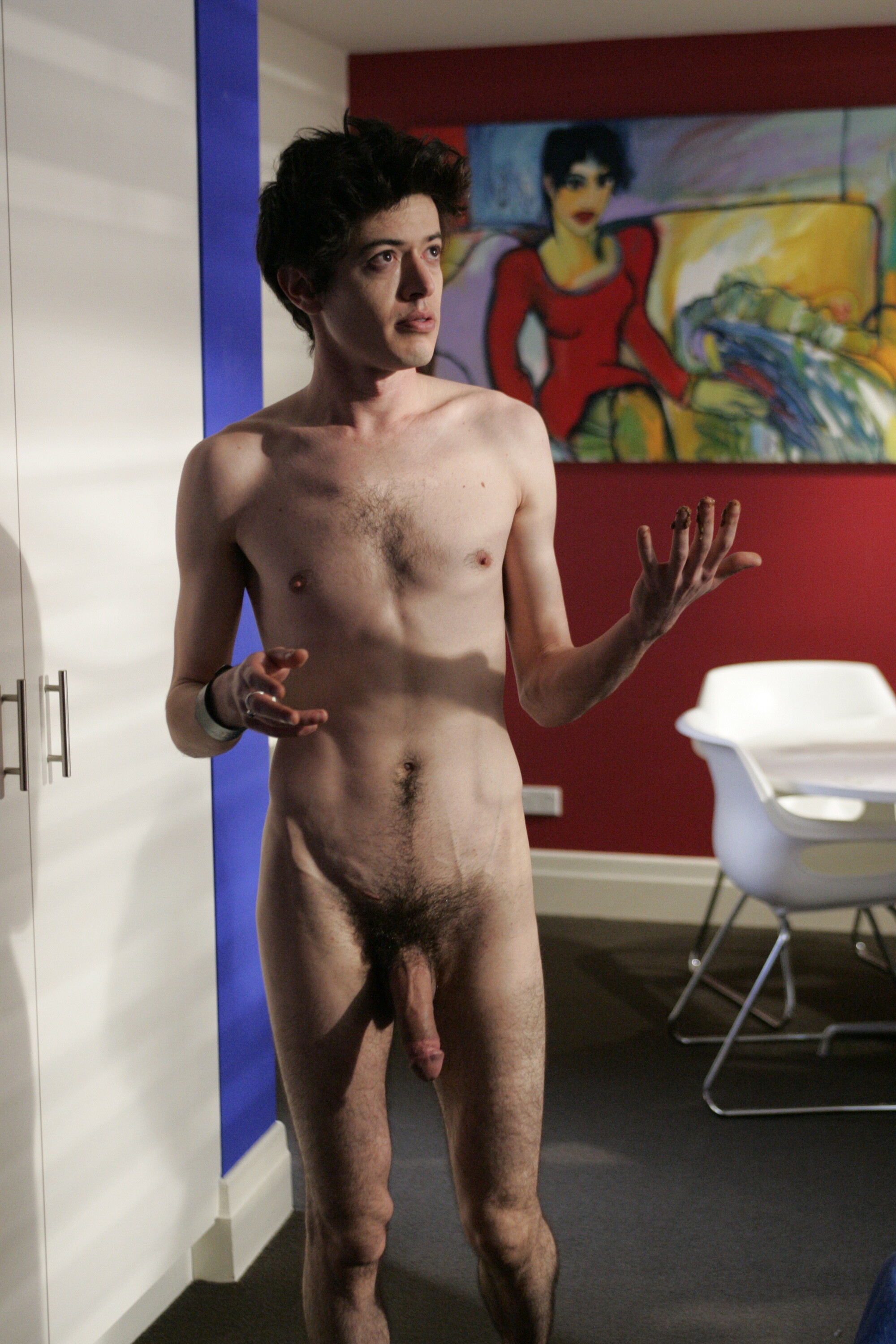
D’Adamo never aspired to make a feature-length film so perhaps the comparison is an unfair one, guided only by the wardrobe parallels.2 But I know Segbedzi is a long-time Girls Out West subscriber, even if D’Adamo has never sighted it. He mentioned to D’Adamo that I had done porn (thanks) but didn’t mention for whom or his own connection to it. So perhaps silent (or even unknown) appropriation is the point. Jeff Koons said of his infamous Made in Heaven series: “First of all, I’m not interested in pornography … Pornography is just performing a sexual act … I’m interested in love.”3 Ilona Staller (aka Cicciolina), Koons claims, “was a ready-made for me.”4 Charming. By resituating an object (his wife) within the transformative context of the gallery, he elevated her to an object of amorous contemplation and stripped her of “use-value” (and any claims to authorship). Incidentally, plush animals were a hallmark of Cicciolina’s films (particularly The Rise of the Roman Empress, 1986) and personal appearances as well as Koons’ appropriation of her oeuvre in the Made in Heaven series.5 Is a little Duchampian re-contextualisation still all we need?
Pornhub thinks so, in reverse. When they released their “Classic Nudes” (2021) erotic art guide, it was Cicciolina who read their tagline out in a Safe for Work advertisement: “Because porn may not be considered art, but some art can definitely be considered porn.” The museum tours even included x-rated content from the well-known amateur real-life couple “MySweetApple” who recreated classics like Titian’s Venus of Urbino (1538), Edgar Degas’s Male Nude (1856), Jan Gossaert’s Adam and Eve (1525). It was all very classically arty, but I’m not gonna rub one out to it. Personally I didn’t find Tape You horny or arty. Although porn is even more subjective than art and I’m clearly a bit jaded when it comes to porn (and white feminism).6
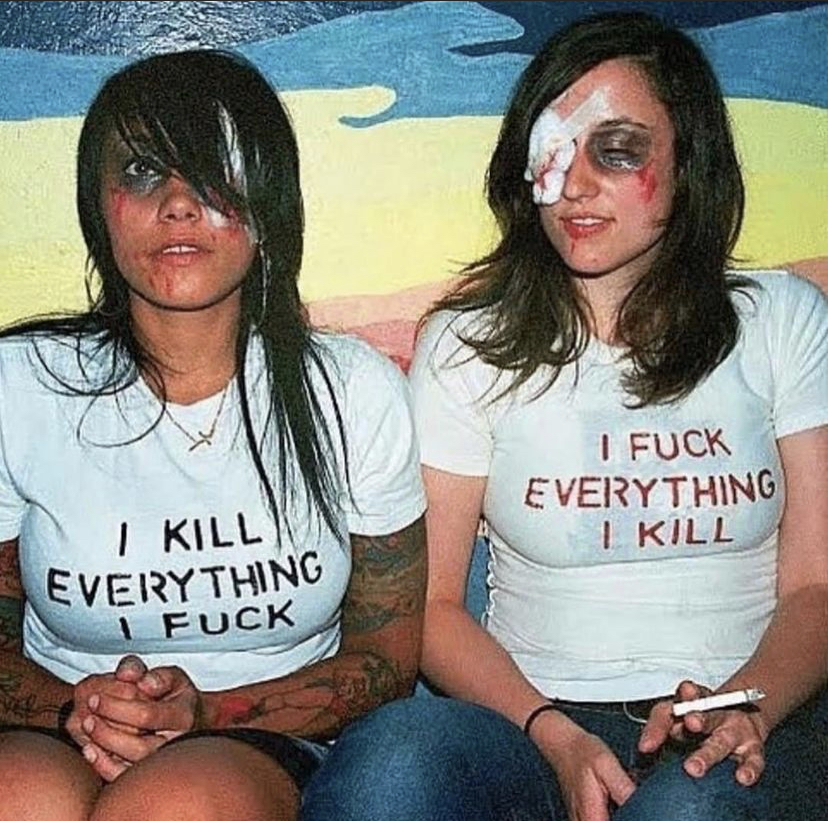
Now we’ve entered the roaring 2020s, it’s worth mentioning that higher hems of the 1920s and 1960s signalled hedonism, youth rebellion, sexual emancipation. Sex, drugs and rock n’ roll as a backlash to the political upheaval of war, the Spanish flu and so forth. Could it be that we are due for a post-Covid moment of “Dionysian excess in miniskirts” as Cameron Hurst wrote in The Right to Viva? Or will it just be a kind of #MeToo, sex positivity/cancel culture backlash that re-invigorates the most cushy of moments for sexual predators like Terry Richardson and Dov Charney? All cycles are alike it seems: feminism loves a moment of fervour followed by a regression and so does capitalism. It’s all a bit boom and bust (a nut).7
The 2022 Miu Miu micro-mini has also been linked to another more prodigious influence by twenty-five year old designer Sintra Martins—SpongeBob SquarePants (1999-). An influence for many Gen Z content creators such as TikTok star Luke Blovad (a big indie sleaze revivalist whose outfits often resemble D’Adamo’s characters’). In the Tape You exhibition space there was also a BAPE logo—a brand who happened to have collaborated with Nickelodeon on a SpongeBob line of clothing and plush toys. This connection is crucial when you consider that the pandemic saw a spike in ADHD diagnoses and that a 2011 study found that just nine minutes of SpongeBob screen time causes learning problems such as short-term attention in four-year-olds. As opposed to sexual revolution, the signal I’m picking up is a more sinister attention deficit-driven LARP with signifiers plucked from the neuro-stimuli vortex that moves too fast to be interpreted or remembered.8

If the point of the exhibition was some sort of elaborate Žižekian over-identification with “female gaze” porn, or the vortex, it could have been exciting. Although for subversive affirmation to work, it has to critically map the ideology—acknowledge our simulacrous image-world and affirm its logic so that it might be transformed into something else. When Amalia Ulman premiered her pornographic work International House Of Cozy (2015) at MAMA in Rotterdam, it approached this sort of action. She made a pornographic adaptation of “creative” lifestyle infomercials, specifically referencing The Selby on Lucy Chadwick for Zara, made with real (non-amateur) porn actors. By replicating both the infomercial and pornography she didn’t critique porn but used porn to signify the final step of legitimising an aesthetic (creative-industry types: Aesop, Artforum, Soho House, Bonne Maman jam, Diptyque candles) and exposed it as a bonafide fetish (the dude cums on a Muji notebook). Not pure irony, but comedic affirmation of the fetishistic creative industries. Pretty silly but seminal work.
There are other references that seem to be more foregrounded for D’Adamo. Stills from Pamela Anderson and Tommy Lee’s 1998 sex tape appear at the top of Morgan’s text, which is relevant considering that Hulu’s Pam & Tommy premiered in February this year and focussed on their early internet-era trauma (without Anderson’s consent). Although not referenced explicitly, it also feels too “timely” to be true that just last week, Ray J threatened to release more footage of Kim Kardashian’s 2007 sex tape. But I hope Tape You isn’t just a comment on this. Feck’s whole IShotMyself premise was to “empower” women to take “control” of their image (in this economy?!) as a backlash to this kind of culture of “revenge porn”. Very “leak your own nudes”. “Rape Me”, Nirvana’s last single release before Cobain took his own life in 1994 also comes to mind, supposedly about being raped by the media. A bit Dworkin “porn is the theory, rape is the practice”? I could also comment on the chosen pseudonym of Lilith and its roots in Mesopotamian and Judaic mythology, but honestly it was such a popular name choice at each company I’ve worked for that we had to start asking people to choose a different one.

What I would like to comment on is Lilith’s panache in showing up to the opening last Friday. Coincidentally one local porn company held a live screening of my first “feature” several years ago (almost 10 years after the fact) and didn’t let me know. I was glad for that. This first foray had a sort of “artistic” premise—I was surrounded by anonymous voyeurs as I lay on a massage table under hot red lights masturbating. It was all a bit “twenty-one-year-old discovers Annie Sprinkle’s Public Cervix Announcement (1990)”. But it was still a porn (quotation marks or no) and the live screening was at a sex party. The thought of people I know watching my (now vintage) porn with all its unflattering angles and awkward dialogue in private is a bit embarrassing, but stroking chins instead of genitalia at an art opening would be mortifying. Actual wanking (even laughing) feels more honest as a bodily response. Either way, I’m glad I don’t have to watch you watching me.
I’d like to believe the return of indie sleaze just means the return of the micro-mini, blogging, great house parties, electroclash part deux, throwing off the shackles of “good taste” and decorum, ideally for a new and improved summer of love without the moralistic marketised sex positivity. It could be that a phoenix rises from the ashes of history, an optimistic creative destruction moment rather than a passive ghostly/undead one. Might we embrace the vacuum of everything all at once and party like it’s Y2K forever? As a millennial, MD just isn’t what it used to be and I still have that cursed Fisher Sixth Sense. But it’s a bit of an old hat/head perspective; that what might have once been a trend “cycle” formed a vacuum at its core and entrapped us in a repetitious vortex of the untethered image-world. Lost Futures blah blah. D’Adamo told me, “it is what it is”.
On New Year’s Eve of the (other) over-anticipated year of 1984, a live broadcast shared between WNET TV in New York and the Centre Pompidou in Paris called Good Morning, Mr. Orwell by Nam June Paik aired. It’s an awkward digital collage of early computer graphics, live performance, feedback echoes, lags and glitchy virtual backgrounds (a little bit Y2K and very Zoom 2020). It was all about the impending destruction of human intimacy by digital futures. In Laurie Anderson’s section, “The Language of The Future”, she tells the story of being onboard a crashing plane and a post-crash meeting with a “Computerese” speaker. In distorted, pitched-down tones, she recites: “[This is a language of] sounds, of noise, of switching, of signals … a language of the past … this is the language of the on-again off-again future. And it is Digital.” She compares this digital language to a rocky amorous relationship. On and off again, lost and found, boom and bust. The young stars of Tape You are also in a real on-again off-again relationship. Beyond sleaze and Fisherisms, something that is clear from Pornhub’s yearly wraps and the intentions behind Tape You alike is that what we desire is passion, romance, intimacy, something real; because the real itself is the biggest fantasy of all. Right next to hentai.
-
See: Carolee Schneeman, Fuses (1967): https://vimeo.com/512695159; VALIE EXPORT, Tapp und Tastkino (1968-71) and Aktionshose: Genitalpanik (1969); Annie Sprinkle (1981 onwards); Karen Finley, Yams Up My Granny’s Ass (1986) and then later Andrea Fraser, Untitled (2003). ↩
-
D’Adamo did mention that Catherine Breillat’s Romance (1999) was an inspiration, but I personally didn’t catch the link. For more feature-length sleazy gems see: Michael Winterbottom, 9 Songs (2004); John Cameron Mitchell, Shortbus (2006); then sleaze-hanger-on Gaspar Noe, Love (2015). ↩
-
Jeff Koons, Jeff Koons, ed. John Caldwell et al. (San Francisco: San Francisco Museum of Modern Art, 1992), 103. ↩
-
Jeff Koons, Pictures 1980–2002, ed. Thomas Kellein (New York: Distributed Art Publishers, 2002), 25. ↩
-
I also don’t know how many times I had to dress a porn set with plush toys. ↩
-
Koa Beck argues that the goal of white feminism is not to alter the systems that oppress women (namely capitalism), but to succeed within them. It’s basically girl boss accelerationism? ↩
-
That’s Vince’s kinda porn. ↩
-
It was VALIE EXPORT’s argument with Tapp und Tastkino (1968–71) that as long as we are content with a reproduced copy of sexual freedom, the state is spared a real sexual revolution, and it seems the state has managed to avoid it ever since. ↩
